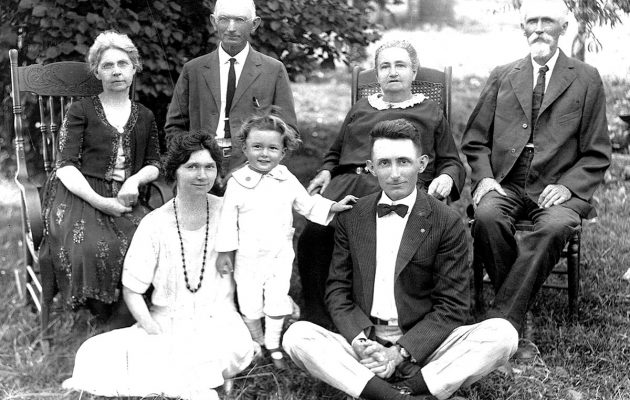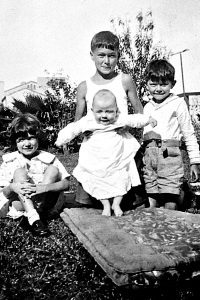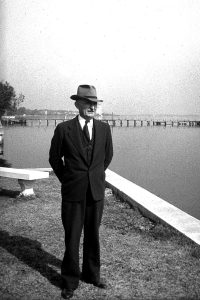The Way We Were: Walter Ford Rogers, Jr.

At age 95, Walter Ford Rogers, Jr.’s memory has not faded. The Avondale native can still vividly recall the day in 1927 when President Calvin Coolidge traveled down Post Street in an open car, as well as the headlines announcing Charles Lindbergh’s flight across the Atlantic, and fighting with his unit behind enemy lines in France during World War II.
But most noteworthy among all his memories are the times spent with his childhood friends – Wilson Baldwin, Malcolm Fortson and Rogers “Tiger” Holmes – all of whom shared his classes at West Riverside Elementary, John Gorrie Junior High and Lee High School.
Born at Riverside Hospital on Feb. 15, 1921 to Walter F. Rogers Sr. and Mary Harrell Rogers, Rogers Jr. grew up on Post Street near John Gorrie Junior High. At that time, Post Street between Stockton and Barrs Streets was not paved, and one day in 1927 President Calvin Coolidge “came down the street in an open car and tipped his hat to me,” said Rogers. Besides presidential processions, Post Street also served as a main hub for the media.
While many people might be acquainted with the iconic image of a newspaper boy on the corner, Rogers heard the sales pitch himself. “Extra, extra read all about it: Lindbergh Lands in Paris!” was a headline shouted out when he was six years old, and he remembers it well.

Rogers children in 1932: Walter supporting Henry; twins Minerva (left) and John (right)
In 1929 Walter Sr. bought the Florida Yacht Club (currently the site of River Shore Village condominiums) and turned it into a single-family home. Life was good in the neighborhood, and while Rogers recalls the Great Depression as a bad time, “we always had enough to eat,” he said.
Growing up in the 1920s and 30s, times were simple. “Boys played marbles and ball. Girls did hopscotch, jump rope, rock-the-cradle,” Rogers explained. Additionally, the pastimes were gender-specific. “Jacks were a girls’ game,” Rogers said emphatically.
Since money for many families was scarce, the children of the early 20th century were forced to invent playthings. Commonplace items could be transformed into toys in an instant, he said, adding that inner tubes made good rubber guns and slingshots. Pop guns were created out of bamboo, with berries for ammunition. Baseball was played freely without an organized team, club, or adult supervision. A pair of roller skates could take him as a far as Memorial Park, and on those days when the kids were too tired to skate, run or even walk, they could count on taking a streetcar Downtown, Rogers said, noting they would pay in tokens and often ride to Herschel Street or even San Juan Avenue in Ortega where the line ended.
Summers were often spent on the Harrell and Rogers family farms in Murfreesboro, Tenn. His father had been born in Smith County, Tenn. in 1889, and never saw an automobile until he was 20, Rogers said. “After World War I, my father got out of the Army and was a young lawyer,” said Rogers. Armed with a Harvard law degree, Rogers’ father moved to Jacksonville after he was offered two jobs, accepting the one that provided better pay. Rogers Sr. was a city councilman and city attorney for South Jacksonville, now the Southbank and San Marco, which at the time was a separate municipality.
Initially when the family traveled north, Rogers Jr. had his parents and grandparents all to himself on their farms. “I had a pony for a while,” Rogers said. Then siblings Minerva, John and Henry were added to the growing family.
In September of 1939, Rogers enrolled in Harvard College in Cambridge, Mass. When the Japanese bombed Pearl Harbor on December 7, 1941, Rogers, a cadet in the Harvard ROTC, crossed the Atlantic Ocean to join back-up troops to the Normandy Invasion.
Landing on the beaches of Normandy, in late June 1944, only a week or two after the historic invasion on June 6, he and his 561st Field Artillery Battalion had moved across France and entered Belgium by autumn. Their fateful mission put the soldiers directly in the path of the German 1st SS Panzer division with 500,000 troops. The Battle of the Bulge had begun. It was December 16, 1944. From December 17th to the 23rd, the Americans retreated but readied for a counterattack on Christmas Eve.
In his memoirs entitled, “Summary of Military Service in World War II,” Rogers wrote “The rest of the war in Germany proceeded favorably, crossing the Siegfried Line fortifications, the Roer and the Rhine Rivers, and reaching the Elbe River, which divided the American and Russian zones, by May 1. The Germans surrendered on May 8, 1945, V-E Day!”
Recalling when the Allies were celebrating their hard-won accomplishment, Rogers described the atmosphere in Paris as one of parades along the Champs-Élysées and parties at the Arc de Triomphe with nurses in fancy uniforms. “Girls would dance and kiss,” said Rogers. “We had a happy day.”

Walter Rogers Sr. in the yard on
St. Johns Avenue in 1947.
The Avondale native’s bravery earned him a Letter of Commendation from General Charles de Gaulle. On the dining room wall in his home hangs the certificate, insignias, and two medals, including a Croix de Guerre, with Silver Star, a French military decoration.
Upon returning to the United States, Rogers began Harvard Law School and started a family with his wartime-bride Dorothy Arnold of Ortega Point, whom he married on June 26, 1943. Together they had two children, son Arnold and daughter Winfield.
As a lawyer, Rogers and his wife enjoyed an active social life. He recalls with fond recollection joining a special dinner group that formed around 1960 with three other couples: Malcolm and Katherine Fortson, Wilson and Julia Baldwin, and Bill and Betty Skinner.
The Rogers were married 43 years, and Dorothy died on July 30, 1986.
Rogers later married Janet Rowland on May 4, 1991 and moved to Neptune Beach. Walter and Janet continued the dinner group tradition and traveled to Missouri and Europe. When Janet passed away on May 4, 2007, Walter continues to stay in close contact with her daughters from a previous marriage.
At age 96, Rogers still lives on his own in the home he shared with Janet. His daughter, Winfield Duss, an Ortega Forest resident, said he spends one night a week with her so he can play poker with his Avondale buddies, a routine they’ve kept up for 30 years.
Wearing their poker hats (navy-blue baseball caps with their names on them), John Allen, 92, Dave Howard, 97 and Rogers comprise the original group. Malcolm Fortson, 95, and Wilson Baldwin, who died in 2013, played in the past, as did Allen’s older brother Wallace until his death a couple of years ago, too. Howard’s son, Hayes, has joined the group.
“Last week he managed to lose six dollars,” Duss said. Winnings are generally in the range of $1.85, she said, noting it’s all in good fun and a chance for her father to connect with pals as far back as high school.
By Ellin Iselin
Resident Community News




 (3 votes, average: 4.33 out of 5)
(3 votes, average: 4.33 out of 5)

